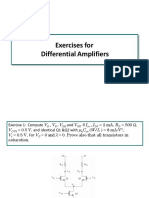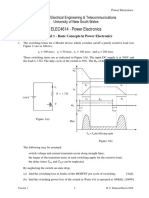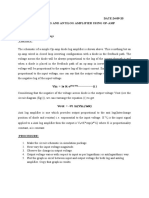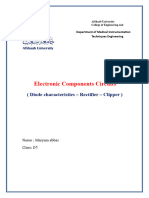The Diode in The DC and Ac Circuit
The Diode in The DC and Ac Circuit
Uploaded by
Christian EspanolCopyright:
Available Formats
The Diode in The DC and Ac Circuit
The Diode in The DC and Ac Circuit
Uploaded by
Christian EspanolOriginal Description:
Original Title
Copyright
Available Formats
Share this document
Did you find this document useful?
Is this content inappropriate?
Copyright:
Available Formats
The Diode in The DC and Ac Circuit
The Diode in The DC and Ac Circuit
Uploaded by
Christian EspanolCopyright:
Available Formats
THE DIODE IN DC AND AC CIRCUIT
1. OBJECTIVES: Be able to measure the current through the diode and the
Input and Output voltages as a function diode polarity. 1.) When
applying DC; 2.) When applying AC
2. CIRCUIT
3. LIST OF EQUIPMENT AND COMPONENTS
MULTISIM / LIVE 1 – 6V AC/DC Power Supply
1 – Diode 1 – AMMETER (P/I)
2 – VOLTMETERS (P/I) 1 – Resistor 10K ohm
1 – LAMP 6V/1W Grapher: V=+/- 10V, T/div= 5mS/div 4.
PROCEDURES
4.1 Assemble the circuit. Put a jumper across the diode, apply 6Vdc, then measure the
current and input/output voltages. Tabulate the result.
4.2 Remove the jumper then measure the current & input/output voltages. Tabulate
the result. Display then draw the Output Voltage Waveform using Grapher.
4.3 Reversed the connection of the diode. Measure the current & voltages. Tabulate
the result. Display then draw the Output Voltage Waveform using Grapher.
4.4 Replace the power source with an AC power supply and then put a jumper across
the diode. Measure the current and input/output voltages. Tabulate the result.
4.5 Remove the jumper across the diode then measure the output current & voltages.
Tabulate the result. Display then draw the Input/output Voltage Waveform using
Grapher.
4.6 Reversed the connection of the diode. Measure the current & voltages. Tabulate
the result. Display then draw the Input/output Voltage Waveform using Grapher.
4.7 Repeat steps 4.1 to 4.6 this time replace the resistor with a lamp.
Type of Diode Polarity I / mA I / mA Vo / V
Input 10K ohm LAMP
Voltage
6V DC W/out diode (JUMPER) 0.5mA 166.66 mA 0V
6V DC W/ diode Forward Bias 0.43663 mA 144.89 mA 0.87 v
6V DC W/ diode Reversed Bias 0.00000000050mA 50 x10^-10 12 x10^-11
mA mA
6V AC W/out diode (JUMPER) 0.84725mA 222.29 mA 1.33 V
6V AC W/ diode 0.75779 mA 190.51 mA 1.22 V
6V AC W/ diode, Reversed 0.00000000036 mA -98.489 mA -0.59 V
5. CONCLUSION
5.1 What is the effect of reversing the polarity of the diode in a DC
circuit?
Reverse polarity occurs when the positive and negative outputs of a
power supply are connected to the incorrect terminals on a PCB. This
error can result in catastrophic component failure in the form of
smoldering parts, bursting capacitors, and, on rare occasions, an
electrical fire.
5.2 What is the effect of reversing the diode in an AC circuit?
No current will flow until the electric field becomes sufficiently strong
that the diode fails.
5.3 Explain in detail your observation when using a lamp as load with a diode
powered using DC and AC voltages.
I discovered that the current that flows through the lamp to light it
improves both DC and AC outcomes in terms of diode polarity, for both
those with diode forward bias and those without but with jumpers.
5.4 Explain in detail your observation in steps 4.4 and 4.5.
To correct and clip AC signals, diodes are utilized. The rotation of an AC generator
results in a sinusoidal voltage (with no DC offset). Rectification, a step towards AC-to-
DC conversion, can be accomplished by using diode circuits to stop this voltage from
switching polarity. This voltage can be kept from reversing polarity by using diode
circuits; this procedure is known as "rectification" and is a step toward AC to DC
conversion. While significantly limiting current flow in the opposite direction, it permits
easy flow in one direction. Due to their ability to convert alternating current (ac) into
pulsing direct current (dc), diodes are sometimes referred to as rectifiers (dc). Type,
voltage, and current capability are used to rate diodes. Also, as the graph shows, when
using an AC source of electricity and adding the jumper in the circuit, the current and
feedback voltage outcomes are not stable because of the high power of electricity.
You might also like
- Exercises For Differential AmplifiersDocument10 pagesExercises For Differential Amplifiersmohamed reda100% (2)
- CHAPTER 2 Single Phase Power Tutorial QuestionsDocument17 pagesCHAPTER 2 Single Phase Power Tutorial QuestionsFilbert OmbongiNo ratings yet
- TB 228Document10 pagesTB 228Marko BrkićNo ratings yet
- IELR464 - Cap 1 - Deber 03 - BIDocument16 pagesIELR464 - Cap 1 - Deber 03 - BIFrancisco Topón Caiza100% (1)
- EET 305 Topic III - Examples PDFDocument10 pagesEET 305 Topic III - Examples PDFSee MooreNo ratings yet
- MCQ in DC Biasing - BJTsDocument6 pagesMCQ in DC Biasing - BJTsPaolo Perez100% (1)
- Sharqawi CatalogDocument324 pagesSharqawi CatalogDonald Veloso100% (1)
- Supported Inverters Solar Monitoring EnirisDocument87 pagesSupported Inverters Solar Monitoring EnirisBart VerbekeNo ratings yet
- Mosfet AmplifierDocument14 pagesMosfet Amplifierapi-243810683No ratings yet
- Chapter 5 Voltage RegulatorDocument38 pagesChapter 5 Voltage RegulatorLizhe KhorNo ratings yet
- CukDocument28 pagesCukEdon DergutiNo ratings yet
- Httpsengineering.uodiyala.edu.Iquploadsمعلومات20الاقسامقسم20الالكترونيكالمحاضراتالمرحلة20الثانية02 ElectricalCircuit 3Document42 pagesHttpsengineering.uodiyala.edu.Iquploadsمعلومات20الاقسامقسم20الالكترونيكالمحاضراتالمرحلة20الثانية02 ElectricalCircuit 3laiyouliang1020No ratings yet
- Filter CircuitDocument13 pagesFilter CircuitNguyen Tran100% (1)
- Diode Limiters and Clampers ReportDocument19 pagesDiode Limiters and Clampers ReportMG Acdal PagulonNo ratings yet
- Unit 2 - NotesDocument52 pagesUnit 2 - NotesJohnsi JNo ratings yet
- Bipolar Junction Transistor: Unit 3Document56 pagesBipolar Junction Transistor: Unit 3adamwaizNo ratings yet
- Ec Ii Unit3Document23 pagesEc Ii Unit3Unmesh PeriNo ratings yet
- First Order RC High Pass Filter: ObjectivesDocument4 pagesFirst Order RC High Pass Filter: ObjectivesismailNo ratings yet
- Three Phase ChopperDocument5 pagesThree Phase Choppercknandhana590No ratings yet
- Lab 1 (1903069)Document6 pagesLab 1 (1903069)Tahsin Zaman TalhaNo ratings yet
- The N-R Power Flow: 5-Bus Example: T1 T2 800 MVA 345/15 KV 520 MVA Line 3 345 KV 50 Mi 1 4 3 5Document47 pagesThe N-R Power Flow: 5-Bus Example: T1 T2 800 MVA 345/15 KV 520 MVA Line 3 345 KV 50 Mi 1 4 3 5Ergin ÖzdikicioğluNo ratings yet
- Igbt BasicsDocument16 pagesIgbt BasicsRahul SoniNo ratings yet
- Power Electronics Lab Experiment-No. 6 Single-Phase Full and Half Wave Controlled SCR Rectifier Aim: To Study and Analyze The Properties and The Characteristics of A Single-PhaseDocument6 pagesPower Electronics Lab Experiment-No. 6 Single-Phase Full and Half Wave Controlled SCR Rectifier Aim: To Study and Analyze The Properties and The Characteristics of A Single-Phaseحسن علي جاسمNo ratings yet
- PUT Experiment EditedDocument9 pagesPUT Experiment EditedReineirDuranNo ratings yet
- SC Chapter 3 - Zener DiodeDocument37 pagesSC Chapter 3 - Zener DiodelornfateNo ratings yet
- AEC Lab ManualDocument75 pagesAEC Lab Manualphalanetra100% (1)
- Tribhuwan University: Lab No:..... Sinusoidal OscillatorsDocument5 pagesTribhuwan University: Lab No:..... Sinusoidal OscillatorsKRSTNo ratings yet
- P-N Junction Diode CharacteristicsnewDocument5 pagesP-N Junction Diode CharacteristicsnewHarish GANANATHAN SBNo ratings yet
- Half Wave & Full Wave RectifiersDocument19 pagesHalf Wave & Full Wave RectifiersRNKNo ratings yet
- Assignment EdsDocument19 pagesAssignment EdsejalzzNo ratings yet
- Chapter 1c (RECTIFIER)Document15 pagesChapter 1c (RECTIFIER)Akmal Amyrul Aizat100% (1)
- CHAPTER 6-Jfet Part ADocument51 pagesCHAPTER 6-Jfet Part Adeafrida oxaura100% (2)
- Lecture 1-Single-Phase-Controlled-RectifiersDocument41 pagesLecture 1-Single-Phase-Controlled-RectifiersmadihaNo ratings yet
- EX.3 Small Signal Analysis of Diode PDFDocument17 pagesEX.3 Small Signal Analysis of Diode PDFram charan100% (1)
- Mos Field-Effect Transistors (Mosfets) : Section 5.1: Device Structure and Physical OperationDocument16 pagesMos Field-Effect Transistors (Mosfets) : Section 5.1: Device Structure and Physical OperationJohn Paul Alcantara Nidoy100% (1)
- BJT Load LineDocument5 pagesBJT Load LineSunilAjmeeraNo ratings yet
- Tutorial 1 - Basic Concepts in Power ElectronicsDocument7 pagesTutorial 1 - Basic Concepts in Power ElectronicsJohn Appleseed100% (2)
- Clipper and ClamperDocument12 pagesClipper and ClamperPanshu kumarNo ratings yet
- The Depletion Type MOSFETDocument4 pagesThe Depletion Type MOSFETsarvajee216No ratings yet
- Steady-State Equivalent Circuit Modeling, Losses, and EfficiencyDocument20 pagesSteady-State Equivalent Circuit Modeling, Losses, and EfficiencyhassanNo ratings yet
- "Single Phase Full Wave Rectifier": Power Point Presentation OnDocument12 pages"Single Phase Full Wave Rectifier": Power Point Presentation Onshadan alamNo ratings yet
- Lab#7: Study of Common Emitter Transistor Amplifier CircuitDocument6 pagesLab#7: Study of Common Emitter Transistor Amplifier CircuitLeandro ZamaroNo ratings yet
- Power Electronics - Chapter 4 - Rectifiers AnalysisDocument40 pagesPower Electronics - Chapter 4 - Rectifiers Analysiskennedy kipsangNo ratings yet
- EDC Question BankDocument13 pagesEDC Question BankvenzkrishNo ratings yet
- Aim: To Test Differentiator and Integrator Circuits Using Ua741op-AmpDocument8 pagesAim: To Test Differentiator and Integrator Circuits Using Ua741op-AmpAvinash Nandakumar100% (2)
- 9 CE AmplifierDocument5 pages9 CE AmplifierAnsh PratapNo ratings yet
- IC 555 Timer Astable Monostable Bistable MultivibratorDocument4 pagesIC 555 Timer Astable Monostable Bistable MultivibratorT BlackNo ratings yet
- Chapter 7 - IC Logic FamilyDocument33 pagesChapter 7 - IC Logic Familyswathich6No ratings yet
- Solved Problems To Chapter 09Document4 pagesSolved Problems To Chapter 09REjosh BonifacioNo ratings yet
- Ecet321l - E1 - Single Stage Ce AmplifierDocument9 pagesEcet321l - E1 - Single Stage Ce AmplifierKenneth Domingo100% (1)
- Experiment # 1: P-N Junction Diode: TheoryDocument9 pagesExperiment # 1: P-N Junction Diode: Theorypoonginithi040% (1)
- Experiment No:-07 DATE:24-09-20 Aim: To Realize Log and Antilog Amplifier Using Op-AmpDocument9 pagesExperiment No:-07 DATE:24-09-20 Aim: To Realize Log and Antilog Amplifier Using Op-AmpJainil ShahNo ratings yet
- Experiment Name-Study of Wein Bridge OscillatorDocument2 pagesExperiment Name-Study of Wein Bridge Oscillatormrana_56100% (1)
- RC Phase Shift OscillatorDocument3 pagesRC Phase Shift Oscillatoreseses100% (2)
- EC - Unit 4 - Negative FeedbackDocument12 pagesEC - Unit 4 - Negative Feedbacknanobala15100% (2)
- Observation of Polarity Test of A Single Phase TransformerDocument3 pagesObservation of Polarity Test of A Single Phase TransformerAbdul Mubin100% (2)
- Clipper Circuits - Clipping Circuits, Series, Positive, Negative, Parallel, Biased - D&E NotesDocument6 pagesClipper Circuits - Clipping Circuits, Series, Positive, Negative, Parallel, Biased - D&E NotesManjunath BadigerNo ratings yet
- EEM328 Electronics Laboratory - Report2 - Diode CharacteristicsDocument9 pagesEEM328 Electronics Laboratory - Report2 - Diode Characteristicsdonatello8480% (5)
- Full Wave RectificationDocument8 pagesFull Wave Rectificationarowona.hamidNo ratings yet
- Electronic Components Circuits: (Diode Characteristies - Rectifier - Clipper)Document14 pagesElectronic Components Circuits: (Diode Characteristies - Rectifier - Clipper)em2200139No ratings yet
- Experiment 3Document6 pagesExperiment 3Mulalo Tharaga MulaudziNo ratings yet
- Applied electronics lab reportDocument21 pagesApplied electronics lab reporttedytedros708No ratings yet
- Latest LabDocument11 pagesLatest LabSam LiangNo ratings yet
- Strain GuageDocument6 pagesStrain GuageChristian EspanolNo ratings yet
- The Full Wave Bridge Rectifier CirccuitDocument3 pagesThe Full Wave Bridge Rectifier CirccuitChristian EspanolNo ratings yet
- Experiment No. 8 Kirchhoffs LawDocument5 pagesExperiment No. 8 Kirchhoffs LawChristian EspanolNo ratings yet
- DNA Extraction MaterialsDocument2 pagesDNA Extraction MaterialsChristian EspanolNo ratings yet
- Months Officers Members Council: I. Membership CompositionDocument2 pagesMonths Officers Members Council: I. Membership CompositionChristian EspanolNo ratings yet
- Demand and Supply Curve For Aramco'SDocument5 pagesDemand and Supply Curve For Aramco'Ssnehass2102100% (1)
- JEE Mains 2023 Shift 1 Question Paper 8 Apr With Solutions PDFDocument19 pagesJEE Mains 2023 Shift 1 Question Paper 8 Apr With Solutions PDFSAUMIL SINHANo ratings yet
- T.anh - ĐỀ SỐ 2-12-chuongtrinhmoiDocument6 pagesT.anh - ĐỀ SỐ 2-12-chuongtrinhmoijxjxjjdkxj988No ratings yet
- E0.02 ELECTRICAL SCHEDULES Rev.0Document1 pageE0.02 ELECTRICAL SCHEDULES Rev.0Abdul RahmanNo ratings yet
- Zera 2019Document62 pagesZera 2019Alex Rh RhNo ratings yet
- 416 - 1 - 1 - Shift Attndant EveningDocument16 pages416 - 1 - 1 - Shift Attndant Eveningsk.saini056No ratings yet
- Namma Kalvi 12th Chemistry Unit 1 PPT Material em 219313Document64 pagesNamma Kalvi 12th Chemistry Unit 1 PPT Material em 219313Anant Mathew SibyNo ratings yet
- Solar IndustriesDocument313 pagesSolar IndustriesReTHINK INDIANo ratings yet
- SC-144 Series: Consumables & Spare Parts Reference CardDocument2 pagesSC-144 Series: Consumables & Spare Parts Reference CardpoloniusNo ratings yet
- Esquema Hidráulico R1700k CarregadeiraDocument20 pagesEsquema Hidráulico R1700k CarregadeiraGlaycon AlanNo ratings yet
- MM - Chapter 0Document37 pagesMM - Chapter 0JOSE ADOLFO MONTALVO QUINTAL.No ratings yet
- Hydrogen Production From Water Electrolysis Current Status and Future TrendsDocument17 pagesHydrogen Production From Water Electrolysis Current Status and Future TrendsAbdul RahmanNo ratings yet
- LNG Tanker MannualDocument49 pagesLNG Tanker MannualJohn Cabiativa100% (1)
- Panasonic+Nn St557m, W+inverterDocument16 pagesPanasonic+Nn St557m, W+inverterCarlos Alberto Bandeira SoaresNo ratings yet
- New Holland Wheel Excavator Mh5 6 Mhpus Mhcity Tier3 en Service ManualDocument20 pagesNew Holland Wheel Excavator Mh5 6 Mhpus Mhcity Tier3 en Service Manualjimmie98% (57)
- Waste Heat Recovery SystemDocument32 pagesWaste Heat Recovery SystembooksrumonNo ratings yet
- R Series VitalisDocument2 pagesR Series Vitaliscextra labNo ratings yet
- Dictionary (N, O)Document16 pagesDictionary (N, O)Lưu Tuấn ĐạtNo ratings yet
- Prius ZVW5Document42 pagesPrius ZVW5Micah K100% (1)
- Basic Knowledge of Turbine Supervisory Instrument (TSI) System - LinkedInDocument7 pagesBasic Knowledge of Turbine Supervisory Instrument (TSI) System - LinkedInSasi NimmakayalaNo ratings yet
- Btech Ee 7 Sem Utilization of Electrical Energy and Electric Traction Kee079 2022Document2 pagesBtech Ee 7 Sem Utilization of Electrical Energy and Electric Traction Kee079 2022vgi21bee.krishanNo ratings yet
- Ucc 28750Document52 pagesUcc 28750eneas.baroneNo ratings yet
- Application For FBLDocument2 pagesApplication For FBLkudarwaksNo ratings yet
- Gabungan Pekan 55Document5 pagesGabungan Pekan 55Break LimsNo ratings yet
- JSA 12-Rev.02 - Pipe or Spool Erection by Using of Chain Blocks or Rope PulleyDocument3 pagesJSA 12-Rev.02 - Pipe or Spool Erection by Using of Chain Blocks or Rope Pulleygolusinghdata0% (1)
- Production of Methyl Tertiary Butyl Ether Using Snamprogetti ProcessDocument103 pagesProduction of Methyl Tertiary Butyl Ether Using Snamprogetti ProcessMuntazer QasimNo ratings yet
- Heat Exchanger (Radiator)Document25 pagesHeat Exchanger (Radiator)Rohan PurohitNo ratings yet






























































































